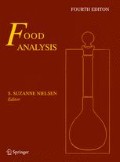Abstract
Vitamins are defined as relatively low-molecular-weight compounds which humans, and for that matter, any living organism that depends on organic matter as a source of nutrients, require small quantities for normal metabolism. With few exceptions, humans cannot synthesize most vitamins and therefore need to obtain them from food and supplements. Insufficient levels of vitamins result in deficiency diseases [e.g., scurvy and pellagra, which are due to the lack of ascorbic acid (vitamin C) and niacin, respectively].
Access this chapter
Tax calculation will be finalised at checkout
Purchases are for personal use only
11.7 References
Eitenmiller RR, Ye L, Landen WO, Jr (2008) Vitamin analysis for the health and food sciences, 2nd edn., p. 135. Taylor & Francis Group, CRC Press, Boca Raton, FL
AOAC International (2007) Official methods of analysis, 18th ed., 2005; Current through revision 2, 2007 (On-line). AOAC International, Gaithersburg, MD
European Committee for Standardization, Technical Committee CEN/TC 275 (2000) Foodstuffs – determination of Vitamin A by high performance liquid chromatography – Part 1: measurement of all-trans-Retinol and 13-cis-Retinol, EN 12823-1
European Committee for Standardization, Technical Committee CEN/TC 275 (2000) Foodstuffs – determination of Vitamin A by high performance liquid chromatography – Part 2: measurement of β-Carotene, EN 12823-2
European Committee for Standardization, Technical Committee CEN/TC 275 (2000) Foodstuffs – determination of Vitamin D by high performance liquid chromatography – measurement of cholecalciferol (D3) and ergocalciferol (D2), EN 12821
European Committee for Standardization, Technical Committee CEN/TC 275 (2000) Foodstuffs – determination of Vitamin E by high performance liquid chromatography – measurement of α-, β-, γ- and δ-Tocopherols, EN 12822
European Committee for Standardization, Technical Committee CEN/TC 275 (2003) Foodstuffs – determination of Vitamin K by HPLC, EN 14148
European Committee for Standardization, Technical Committee CEN/TC 275 (2003) Foodstuffs – determination of Vitamin C by HPLC, EN 14130
European Committee for Standardization, Technical Committee CEN/TC 275 (2003) Foodstuffs – determination of Vitamin B1 by HPLC, EN 14122
European Committee for Standardization, Technical Committee CEN/TC 275 (2003) Foodstuffs – determination of Vitamin B2 by HPLC, EN 14152
United States Pharmacopeial Convention (2005) US Pharmacopoeia National Formulary, USP29/NF24, Nutritional Supplements, Official Monographs, United States Pharmacopoeial Convention, Rockville, MD
Ball GFM (2006) Vitamins in foods. Analysis, bioavailability, and stability. Taylor & Francis Group, CRC Press, Boca Raton, FL.
Blake CJ (2007) Analytical procedures for water-soluble vitamins in foods and dietary supplements: a review. Anal Bioanal Chem 389:63–76
Eitenmiller RR, De Souza S (1985) Niacin. In: Augustin J, Klein BP, Becker DA, Venugopal PB (eds) Methods of vitamin assay, 4th edn. Wiley, New York, pp 685–397.
De Souza S, Eitenmiller RR (1990) Effects of different enzyme treatments on extraction of total folate from various foods prior to microbiological assay and radioassay. J Micronutrient Anal 7:37–57.
Tamura T (1990) Microbiological assay of folates. In: Picciano MF, Stokstad ELR, Gregory JF III (eds) Folic acid metabolism in health and disease, contemporary issues in clinical nutrition, Vol. 13. Wiley-Liss, New York, pp 121–137
Institute of Medicine (2000) Dietary reference intakes for vitamin c, vitamin e, selenium and carotenoids. National Academy Press, Washington, DC
Lee J, Ye L, Landen WO Jr, Eitenmiller RR (2000) Optimization of an extraction procedure for the quantification of Vitamin E in tomato and broccoli using response surface methodology. J Food Compos Anal 13:45–57
Pelletier O (1985) Vitamin C (l-ascorbic and dehydro-l-ascorbic acid). In: Augustin J, Klein BP, Becker DA, Venugopal PB (eds) Methods of vitamin assay, 4th edn. Wiley, New York, pp 335–336
Pelletier O (1985) Vitamin C (l-ascorbic and dehydro-l-ascorbic acid). In: Augustin J, Klein BP, Becker DA, Venugopal PB (eds) Methods of vitamin assay, 4th edn. Wiley, New York, pp 338–341
AACC International (2010) Approved methods of analysis, 11th edn. (On-line), AACC International, St. Paul, MN
Author information
Authors and Affiliations
Corresponding author
Rights and permissions
Copyright information
© 2010 Springer Science+Business Media, LLC
About this chapter
Cite this chapter
Pegg, R.B., Landen, W.O., Eitenmiller, R.R. (2010). Vitamin Analysis. In: Food Analysis. Food Analysis. Springer, Boston, MA. https://doi.org/10.1007/978-1-4419-1478-1_11
Download citation
DOI: https://doi.org/10.1007/978-1-4419-1478-1_11
Published:
Publisher Name: Springer, Boston, MA
Print ISBN: 978-1-4419-1477-4
Online ISBN: 978-1-4419-1478-1
eBook Packages: Chemistry and Materials ScienceChemistry and Material Science (R0)

